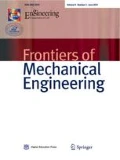Abstract
A support system is the main load-bearing component of sample table for neutron stress spectrometer, and air bearing is an important element of a support system. The neutron stress spectrometer sample table was introduced, and the scheme for air bearing combination was selected. To study the performance of air bearing center cross gap, finite element models (FEMs) were established based on air motion and Reynolds equations, effects of air supply pressure, and gap parameters on the overturning moment and bearing capacity of air bearing center cross gap were analyzed. Results indicate that the width, depth, and height differences of the marble floor gap played important roles in the performance of the air bearing. When gap width is lesser than 1 mm and gap depth is lower than 0.4 mm, bearing capacity and overturning moment would vary rapidly with the variation of the width and depth. A gap height difference results in the bearing capacity dropping rapidly. The FEM results agree well with experimental results. Further, findings of the study could guide the design of the support system and marble floor.
Similar content being viewed by others
References
Chen M F, Lin Y T. Static behavior and dynamic stability analysis of grooved rectangular aerostatic thrust bearings by modified resistance network method. Tribology International, 2002, 35(5): 329–338
Renn J, Hsiao C. Experimental and CFD study on the mass flow-rate characteristic of air through orifice-type restrictor in aerostatic bearings. Tribology International, 2004, 37(4): 309–315
Luong T S, Potze W, Post J B, et al. Numerical and experimental analysis of aerostatic thrust bearings with porous restrictors. Tribology International, 2004, 37(10): 825–832
Belforte G, Raparelli T, Viktorov V, et al. Discharge coefficients of orifice-type restrictor for aerostatic bearings. Tribology International, 2007, 40(3): 512–521
Li Y, Ding H. Influences of the geometrical parameters of aerostatic thrust bearing with pocketed orifice-type restrictor on its performance. Tribology International, 2007, 40(7): 1120–1126
Stout K J, Barrans S M. The design of aerostatic bearings for application to nanometre resolution manufacturing machine systems. Tribology International, 2000, 33(12): 803–809
Belforte G, Colombo F, Raparelli T, et al. Performance of externally pressurized grooved thrust bearings. Tribology Letters, 2010, 37(3): 553–562
Belforte G, Colombo F, Raparelli T, et al. Comparison between grooved and plane aerostatic thrust bearings: Static performance. Meccanica, 2011, 46(3): 547–555
Eleshaky M E. CFD investigation of pressure depressions in aerostatic circular thrust bearings. Tribology International, 2009, 42 (7): 1108–1117
Miyatake M, Yoshimoto S. Numerical investigation of static and dynamic characteristics of aerostatic thrust bearings with small feed holes. Tribology International, 2010, 43(8): 1353–1359
Hou Y, Zhao X, Chen S, et al. Numerical analysis of externally pressurized gas thrust bearing with supply hole. Lubrication Engineering, 2008, 33(9): 1–3 (in Chinese)
Huang H, Liu P, Dong Z. The performances simulation of aerostatic thrust bearing. Computer Simulation, 2010, 28(3): 340–343 (in Chinese)
Long W. Study on loading characteristics of orifice compensated aerostatic thrust bearing. Dissertation for the Doctoral Degree. Harbin: Harbin Institute of Technology, 2010 (in Chinese)
Long W, Li J, Bao G. Application of FLUENT in the research of air bearing field. Machine Tool & Hydraulics, 2006, 34(6): 151–153
Zhang J. Research on higher stiffness aerostatic bearing. Dissertation for the Doctoral Degree. Xi’an: Northwestern Polytechnical University, 2006 (in Chinese)
Li Y, Lin Y, Zhu H. Performances analysis of aerostatic bearing restricted by fan-shaped surface restrictor. Computer Simulation, 2013, 30(4): 243–247 (in Chinese)
Liu S. Numerical simulation and experimental investigation of the static characteristics of a vacuum preloaded aerostatic bearing. Dissertation for the Master’s Degree. Wuhan: Huazhong University of Science and Technology, 2012 (in Chinese)
Dun L, Liu Y, Chen S. Lubrication of Aerostatic Bearing. Harbin: Harbin Institute of Technology Press, 1990
He X. Dynamics of the ultra-precision positioning stage with gaslubricated bearings. Dissertation for the Doctoral Degree. Wuhan: Huazhong University of Science and Technology, 2007 (in Chinese)
Yang X. Study of static and dynamic characteristics of planar aerostatic bearings. Dissertation for the Doctoral Degree. Wuhan: Huazhong University of Science and Technology, 2012 (in Chinese)
Author information
Authors and Affiliations
Corresponding author
Rights and permissions
About this article
Cite this article
Li, Y., Wu, Y., Gong, H. et al. Air bearing center cross gap of neutron stress spectrometer sample table support system. Front. Mech. Eng. 11, 403–411 (2016). https://doi.org/10.1007/s11465-016-0405-y
Received:
Accepted:
Published:
Issue Date:
DOI: https://doi.org/10.1007/s11465-016-0405-y



